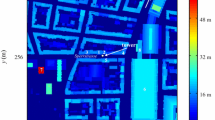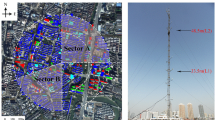Abstract
Full-scale observations from two urban sites in Basel, Switzerland were analysed to identify the magnitude of different processes that create, relocate, and dissipate turbulent kinetic energy (TKE) in the urban atmosphere. Two towers equipped with a profile of six ultrasonic anemometers each sampled the flow in the urban roughness sublayer, i.e. from street canyon base up to roughly 2.5 times the mean building height. This observational study suggests a conceptual division of the urban roughness sublayer into three layers: (1) the layer above the highest roofs, where local buoyancy production and local shear production of TKE are counterbalanced by local viscous dissipation rate and scaled turbulence statistics are close to to surface-layer values; (2) the layer around mean building height with a distinct inflexional mean wind profile, a strong shear and wake production of TKE, a more efficient turbulent exchange of momentum, and a notable export of TKE by transport processes; (3) the lower street canyon with imported TKE by transport processes and negligible local production. Averaged integral velocity variances vary significantly with height in the urban roughness sublayer and reflect the driving processes that create or relocate TKE at a particular height. The observed profiles of the terms of the TKE budget and the velocity variances show many similarities to observations within and above vegetation canopies.
Similar content being viewed by others
References
Amiro BD (1990) Drag coefficients and turbulence spectra within three boreal forest canopies. Boundary-Layer Meteorol 52: 227–246
Belcher SE (2005) Mixing and transport in urban areas. Philos Trans R Soc A 363: 2947–2968
Britter RE, Hanna SE (2003) Flow and dispersion in urban areas. Annu Rev Fluid Mech 35: 469–496
Brunet Y, Finnigan JJ, Raupach MR (1994) Wind-tunnel study of air-flow in waving wheat—single-point velocity statistics. Boundary-Layer Meteorol 70: 95–132
Ca VT, Ashie Y, Asaeda T (2002) A k-epsilon turbulence closure model for the atmospheric boundary layer including urban canopy. Boundary-Layer Meteorol 102: 459–490
Cheng H, Castro IP (2002) Near wall flow over urban-like roughness. Boundary-Layer Meteorol 104: 229–259
Christen A (2005) Atmospheric turbulence and surface energy exchange in urban environments—results from the Basel Urban Boundary Layer Experiment (BUBBLE), vol 11 of stratus. Institute of Meteorology, Climatology and Remote Sensing, Department of Geosciences, University of Basel. 3-85977-266-X
Christen A, Vogt R (2004) Energy and radiation balance of a Central European city. Int J Climatol 24: 1395–1421
Christen A, van Gorsel E, Vogt R (2007) Coherent structures in urban roughness sublayer turbulence. Int J Climatol 27: 1955–1968
Coceal O, Thomas T, Castro I, Belcher S (2006) Mean flow and turbulence statistics over groups of urban-like cubical obstacles. Boundary-Layer Meteorol 121: 491–519
Dwyer MJ, Patton EG, Shaw RH (1997) Turbulent kinetic energy budgets from a large-eddy simulation of airflow above and within a forest canopy. Boundary-Layer Meteorol 84: 23–43
Elliott JA (1972) Microscale pressure fluctuations measured within the lower atmospheric boundary layer. J Fluid Mech 53: 351–383
Feddersen B (2005) Wind tunnel modelling of turbulence and dispersion above tall and highly dense urban roughness, vol 15934 of diss. ETH. Swiss Federal Institute of Technology (ETH), Zürich
Feigenwinter C, Vogt R (2005) Detection and analysis of coherent structures in urban turbulence. Theor Appl Climatol 81: 219–230
Feigenwinter C, Vogt R, Parlow E (1999) Vertical structure of selected turbulence characteristics above an urban canopy. Theor Appl Climatol 62: 51–63
Finnigan JJ (2000) Turbulence in plant canopies. Annu Rev Fluid Mech 22: 519–557
Frenzen P, Vogel CA (2001) Further studies of atmospheric turbulence in layers near the surface: scaling the TKE budget above the roughness sublayer. Boundary-Layer Meteorol 99: 173–206
Garratt JR (1994) The atmospheric boundary layer. Cambridge University Press, UK, p 316
Grimmond CSB, Oke TR (1999) Aerodynamic properties of urban areas derived from analysis of surface form. J Appl Meteorol 38: 1262–1292
Högström U, Bergström H, Alexandersson H (1982) Turbulence characteristics in a near-neutrally stratified urban atmosphere. Boundary-Layer Meteorol 23: 449–472
Kaimal JC, Finnigan JJ (1994) Atmospheric boundary layer flows—their structure and measurement. Oxford University Press, New York, p 289 pp
Kastner-Klein P, Fedorovich E, Rotach MW (2001) A wind-tunnel study of organised turbulent motions in urban street canyons. J Wind Eng Ind Aerodyn 89: 849–861
Katul GG, Albertson JD, Hsieh CI, Conklin PS, Sigmon JT, Parlange MB, Knoerr KR (1996) The ‘inactive’ eddy motion and the large-scale turbulent pressure fluctuations in the dynamic sublayer. J Atmos Sci 6: 2512–2524
Leclerc MY, Beissner KC, Shaw RH, den Hartog G, Neumann HH (1990) The influence of atmospheric stability on the budgets of the Reynolds stress and turbulent kinetic energy within and above a deciduous forest. J Appl Meteorol 29: 916–933
Maier W (2005) 10 Jahre 3D-Stadtmodell Kanton Basel-Stadt. Geomat Schweiz 6: 348–350
Maitani T, Seo T (1985) Estimates of velocity-pressure and velocity pressure gradient interactions in the surface layer above plant canopies. Boundary-Layer Meteorol 33: 51–60
Martilli A, Santiago JL (2007) CFD simulation of airflow over a regular array of cubes. Part II: analysis of spatial average properties. Boundary-Layer Meteorol 122: 635–654
McBean GA, Elliott JA (1975) Vertical transports of kinetic-energy by turbulence and pressure in boundary-layer. J Atmos Sci 32: 753–766
McMillen RT (1988) An eddy correlation technique with extended applicability to non-simple terrain. Boundary-Layer Meteorol 43: 231–245
Meyers TP, Baldocchi DD (1991) The budgets of turbulent kinetic energy and Reynolds stress within and above a deciduous forest. Agric For Meteorol 53: 207–222
Oikawa S, Meng Y (1995) Turbulence characteristics and organized motion in a suburban roughness sublayer. Boundary-Layer Meteorol 74: 289–312
Poggi D, Katul GG, Albertson JD (2004) Momentum transfer and turbulent kinetic energy budgets within a dense model canopy. Boundary-Layer Meteorol 111: 589–614
Press WH, Teukolsky SA, Vetterling WT, Flannery BP (1994) Numerical recipes in C—the art of scientific computing, 2nd edn. Cambridge University Press, Cambridge
Raupach MR, Shaw RH (1982) Averaging procedures for flow within vegetation canopies. Boundary-Layer Meteorol 22: 79–90
Raupach MR, Coppin PA, Legg BJ (1986) Experiments on scalar dispersion within a model-plant canopy. I. The turbulence structure. Boundary-Layer Meteorol 35: 21–52
Raupach MR, Finnigan JJ, Brunet Y (1989) Coherent eddies in vegetation canopies. In: Fourth proc. Australasian conf. heat mass transfer, Christchurch, New Zealand, May 9–12 1989, pp 75–90
Raupach MR, Finnigan JJ, Brunet Y (1996) Coherent eddies and turbulence in vegetation canopies: the mixing-layer analogy. Boundary-Layer Meteorol 78: 351–382
Rotach MW (1993a) Turbulence close to a rough urban surface. II. Variances and gradients. Boundary-Layer Meteorol 66: 75–92
Rotach MW (1993b) Turbulence close to a rough urban surface. I. Reynolds stress. Boundary-Layer Meteorol 65: 1–28
Rotach MW (1999) On the influence of the urban roughness sublayer on turbulence and dispersion. Atmos Environ 33: 401–408
Rotach MW, Gryning SE, Batchvarova E, Christen A, Vogt R (2004) Pollutant dispersion close to an urban surface—the BUBBLE tracer experiment. Theor Appl Climatol 87: 39–56
Rotach MW, Vogt R, Bernhofer C, Batchvarova E, Christen A, Clappier A, Feddersen B, Gryning SE, Martucci G, Mayer H, Mitev V, Oke TR, Parlow E, Richner H, Roth M, Roulet YA, Ruffieux D, Salmond J, Schatzmann M, Voogt J (2005) BUBBLE—an urban boundary layer meteorology project. Theor Appl Climatol 81: 231–261
Roth M (2000) Review of atmospheric turbulence over cities. Q J Roy Meteorol Soc 126: 941–990
Roth M, Oke TR (1993a) Turbulent transfer relationships over an urban surface. I. Spectral characteristics. Q J Roy Meteorol Soc 119: 1071–1104
Roth M, Oke TR (1993b) ‘Turbulent transfer relationships over an urban surface. II. Integral statistics. Q J Roy Meteorol Soc 119: 1105–1120
Roth M, Salmond JA, Satyanarayana ANV (2006) Methodological considerations regarding the measurement of turbulent fluxes in the urban roughness sublayer: the role of scintillometry. Boundary-Layer Meteorol 121: 351–375
Sabatino SD, Kastner-Klein P, Berkowicz R, Britter RE, Fedorovich E (2003) The modelling of turbulence from traffic in urban dispersion models. I. Theoretical considerations. Environ Fluid Mech 3: 129–143
Shaw RH, Paw KT, Zhang XJ, Gao W, den Hartog G, Neumann HH (1990) Retrieval of turbulent pressure fluctuations at the ground surface beneath a forest. Boundary-Layer Meteorol 50: 319–338
Shen SH, Leclerc MY (1997) Modelling the turbulence structure in the canopy layer. Agric For Meteorol 87: 3–25
Tennekes H, Lumley JL (1972) A first course in turbulence. MIT Press, Cambridge
Vogt R, Christen A, Rotach MW, Roth M, Satyanarayana ANV (2006) Temporal dynamics of CO2 fluxes and profiles over a Central European city. Theor Appl Climatol 84(1–3): 117–126
Wilczak JM, Bedard AJ (2004) A new turbulence microbarometer and its evaluation using the budget of horizontal heat flux. J Atmos Ocean Technol 21: 1170–1181
Wilczak JM, Oncley SP, Stage SA (2001) Sonic anemometer tilt correction algorithms. Boundary-Layer Meteorol 99: 127–150
Willis GE, Deardorff JW (1976) On the use of Taylor’s hypothesis for diffusion in the mixed layer. Q J Roy Meteorol Soc 102: 817–822
Wyngaard JC, Clifford SF (1977) Taylor’s hypothesis and high frequency turbulence spectra. J Atmos Sci 34: 922–929
Author information
Authors and Affiliations
Corresponding author
Rights and permissions
About this article
Cite this article
Christen, A., Rotach, M.W. & Vogt, R. The Budget of Turbulent Kinetic Energy in the Urban Roughness Sublayer. Boundary-Layer Meteorol 131, 193–222 (2009). https://doi.org/10.1007/s10546-009-9359-5
Received:
Accepted:
Published:
Issue Date:
DOI: https://doi.org/10.1007/s10546-009-9359-5




